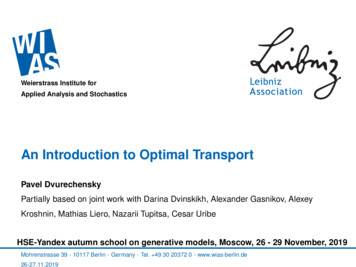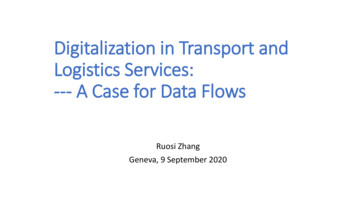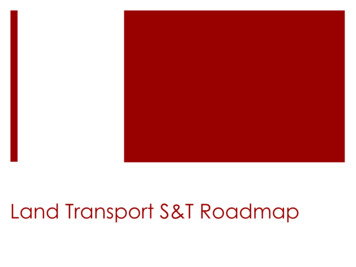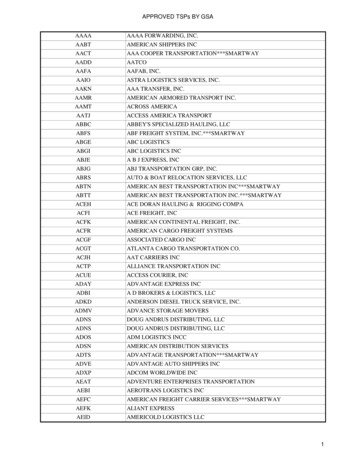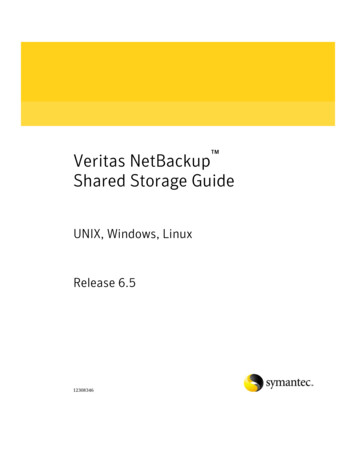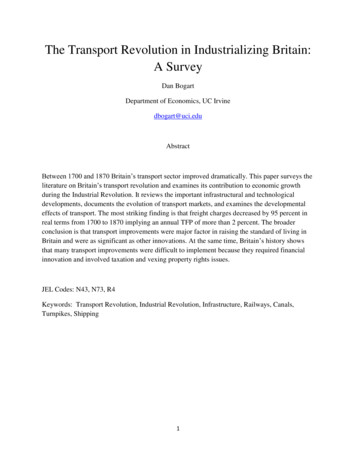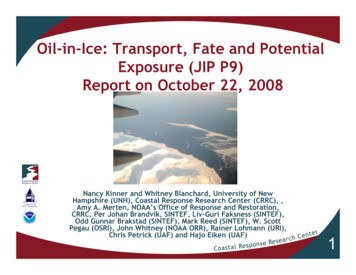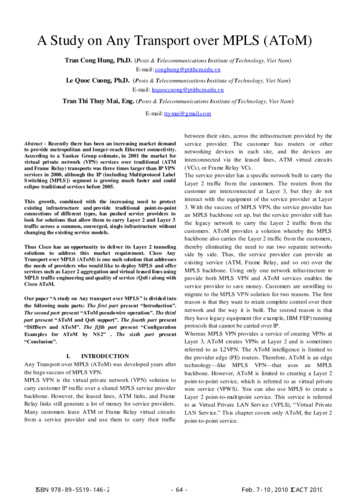
Transcription
A Study on Any Transport over MPLS (AToM)Tran Cong Hung, Ph.D. (Posts & Telecommunications Institute of Technology, Viet Nam)E-mail: conghung@ptithcm.edu.vnLe Quoc Cuong, Ph.D. (Posts & Telecommunications Institute of Technology, Viet Nam)E-mail: lequoccuong@ptithcm.edu.vnTran Thi Thuy Mai, Eng. (Posts & Telecommunications Institute of Technology, Viet Nam)E-mail: tty mai@g mail.co mAbstract - Recently there has been an increasing market demandto provide metropolitan and longer-reach Ethernet connectivity.According to a Yankee Group estimate, in 2001 the market forvirtual private network (VPN) services over traditional (ATMand Frame Relay) transports was three times larger than IP VPNservices in 2000, although the IP (including Multiprotocol LabelS witching [MPLS ]) segment is growing much faster and couldeclipse traditional services before 2005.This growth, combined with the increasing need to protectexisting infrastructure and provide traditional point-to-pointconnections of different types, has pushed service providers tolook for solutions that allow them to carry Layer 2 and Layer 3traffic across a common, converged, single infrastructure withoutchanging the existing service models.Thus Cisco has an opportunity to deliver its Layer 2 tunnelingsolutions to address this market requirement. Cisco AnyTransport over MPLS (AToM) is one such solution that addressesthe needs of providers who would like to deploy MPLS and offerservices such as Layer 2 aggregation and virtual leased lines usingMPLS traffic engineering and quality of service (QoS ) along withCisco AToM.Our paper “A study on Any transport over MPLS ” is divided intothe following main parts: The first part present “Introduction”.The second part present “AToM pseudowire operation”. The thirdpart present “AToM and QoS support”. The fourth part present“DiffServ and AToM”. The fifth part present “ConfigurationExamples for AToM by NS 2” . The sixth part present“Conclusion”.I.INTRODUCTIONAny Transport over MPLS (AToM) was developed years afterthe huge success of MPLS VPN.MPLS VPN is the virtual private network (VPN) solution tocarry customer IP traffic over a shared MPLS service providerbackbone. However, the leased lines, ATM links, and FrameRelay links still generate a lot of money for service providers.Many customers lease ATM or Frame Relay virtual circuitsfro m a service provider and use them to carry their trafficISBN 978-89-5519-146-2between their sites, across the infrastructure provided by theservice provider. The customer has routers or othernetworking devices in each site, and the devices areinterconnected via the leased lines, ATM virtual circu its(VCs), or Frame Relay VCs.The service provider has a specific network built to carry theLayer 2 traffic fro m the customers. The routers from thecustomer are interconnected at Layer 3, but they do notinteract with the equipment of the service provider at Layer3. W ith the success of MPLS VPN, the service provider hasan MPLS backbone set up, but the service provider still hasthe legacy network to carry the Layer 2 traffic fro m thecustomers. AToM provides a solution whereby the MPLSbackbone also carries the Layer 2 traffic fro m the customers,thereby eliminating the need to run two separate networksside by side. Thus, the service provider can provide anexisting service (ATM, Frame Relay, and so on) over theMPLS backbone. Using only one network infras tructure toprovide both MPLS VPN and AToM services enables theservice provider to save money. Customers are unwilling tomigrate to the MPLS VPN solution for two reasons. The firstreason is that they want to retain complete control over theirnetwork and the way it is built. The second reason is thatthey have legacy equipment (for examp le, IBM FEP) runningprotocols that cannot be carried over IP.Whereas MPLS VPN provides a service of creating VPNs atLayer 3, AToM creates VPNs at Layer 2 and is sometimesreferred to as L2VPN. The AToM intelligence is limited tothe provider edge (PE) routers. Therefore, AToM is an edgetechnology—like MPLS VPN—that uses an MPLSbackbone. However, AToM is limited to creating a Layer 2point-to-point service, which is referred to as virtual privatewire service (VPWS). You can also use MPLS to create aLayer 2 point-to-mult ipoint service. This service is referredto as Virtual Private LAN Serv ice (VPLS), ―Virtual PrivateLAN Serv ice.‖ Th is chapter covers only AToM, the Lay er 2point-to-point service.- 64 -Feb. 7-10, 2010 ICACT 2010
Any Transport over MPLS (AToM) is Cisco's solution fortransporting Layer 2 packets over an IP/MPLS backbone.AToM is provided as part of the Unified VPN portfo lio ofleading-edge VPN technologies available over the widestbreadth of Cisco routers. Cisco support for AToM enablesservice providers to provide connectivity between customersites with existing data link layer (Layer 2) networks, by usinga single, integrated, packet-based network infrastructure—aCisco MPLS network. Instead of separate networks withnetwork management environments, service providers candeliver both traditional ATM and Frame Relay connectionsand Ethernet connections over an IP/MPLS backbone.The AToM product set accommodates many types of Layer 2packets, including ATM, Ethernet, Frame Relay, PPP, orHigh-Level Data Lin k Control (HDLC)- based networksacross mult iple Cisco router platforms. With Cisco AToMtechnology, provisioning and connecting is traightforward. Acustomer using Ethernet within a building or campus in onelocation can connect via a service provider offering Ethernetover MPLS to the customer's Ethernet networks in distantlocations. A service provider offering Cisco AToM-basedservices enables Layer 2 networks such as ATM or FrameRelay networks to make new point-to-point connections muchmore easily.With point-to-point virtual circuits built with Cisco AToM, theLayer 2 connections retain their character as VPNs. Thecustomer controls traffic routing within the network, and therouting informat ion resides on the customer's routingequipment. The service provider's packet network equip mentsupplies point-to-point connections or an emulated pseudowire required by the customer.Cisco AToM provides a common framework to encapsulateand transparently transport any traffic type over an MPLSnetwork core. Service providers can use a single IP/MPLSnetwork infrastructure and network management environmentto offer customers connectivity for ATM, Frame Relay,Ethernet, PPP, and High-Level Data Lin k Control (HDLC)traffic, as well as carry customers' IP traffic in Layer 3 VPNs.Importantly, service providers can use Cisco superiorcapabilit ies in QoS to assure appropriate levels of service fordifferent types of traffic. Cisco AToM saves money for serviceproviders, and Cisco QoS provides ways to gain incrementalISBN 978-89-5519-146-2revenueforpremiu mclassesof service.Figure 1-1. Transport of Layer 2 Protocols and Connectionsover AToM PseudowiresIn figure 1-1, ATM traffic is transported over an orIT.SJ.ATM.Switch; PPP traffic is transported over anAToM pseudowire between mjlnet.Los.Angeles.CE andmjlnet. Seattle.CE; and Ethernet traffic is transported over n.Jose.CE.II.ATOM PS EUDOWIRE OPERATIONFigure 2-1 shows how a Layer 2 packet travels from Site 1 toSite 2 in VPN A, using the IP/MPLS backbone .Figure 2-1 Layer 2 packet travels from Site 1 to Site 2 - 65 -The following process shows a Layer 2 packet travelingfro m Customer Edge 1 (CE1) on VPN A (Site 1) acrossthe service-provider network, to CE 2 on VPN A (Site 2).CE1 connects to the Provider Edge 1 (PE1) on theservice-provider network through a traditional Layer 2virtual circu it, such as a Frame Relay, data linkconnection identifier (DLCI 101), virtual circuit. Thepacket travels fro m CE1 to PE1 through that circuit.Feb. 7-10, 2010 ICACT 2010
In the service provider network, an operator configures alabel switched path (LSP) fro m PE1 to PE2For AToM, the operator configures– (At PE1, a cross-connect between Attachment VC 101and Emulated VC1, and the destination PE to be PE2– (b) At PE2, a cross-connect between Emulated VC1and Attachment VC 201, and the source PE to be PE1– Note: No AToM configuration is required on the Prouters.At PE1, the follo wing events take place on the ingressinterface of the router:–An incoming packet on the ingress line card of theprovider-edge router is stripped of the Layer 2 header.– A control word and virtual-circuit label [10] arepushed on the packet.– An appropriate network-facing interface is selected.– A tunnel label is pushed (for normal MPLS routingthrough the cloud).The control word and the virtual-circuit label are pertinentonly to the ingress and egress provider-edge routers. Therouters within the MPLS backbone (the P routers) do notuse the control word or the virtual-circu it label. Instead, theP routers use the tunnel label [50 & 90] to move the packetthrough the MPLS backbone. A P router does notdistinguish AToM traffic fro m other types of traffic. Thepacket is handled just like other packets in the MPLSbackbone. The packet is sent through the service-provider network toPE2.The following events take place on the egress router PE2:– The virtual-circuit label [10] is stripped.– The control word is processed and stripped.– The header is reconstructed.– The packet is sent out the appropriate customer-facinginterface.No tunnel label is present in the network-facing side of therouter because that label was popped by thepenultimate router.PE2 connects to CE2 through a traditional Layer 2 v irtualcircuit, such as Frame Relay (DLCI 102) virtual circuit.III.ATOM AND QOS S UPPORTQoS sorts and classifies packet requests into different trafficclasses and allocates the proper resources to direct trafficbased on various criteria, including application type, user orISBN 978-89-5519-146-2application ID, source or destination IP address, and othervariables.The bits in the packet translate to the priority of the packet.For MPLS packets, the MPLS experimental b its, also knownas the EXP bits, allow you to specify the QoS for an MPLSpacket. For an IP packet, the IP Precedence/differentiatedservices code point (DSCP) b its allo w you to specify the QoSfor an IP packet.When an IP packet travels fro m one site to another, the IPPrecedence field (the first three bits of the DSCP field in theheader of an IP packet) specifies the QoS. Based on the IPPrecedence marking, the packet is given the desiredtreatment such as the latency or the percent of bandwidthallo wed for that class of service. If the service-providernetwork is an MPLS network, then the IP Precedence bits arecopied into the MPLS EXP field at the edge of the network.When an Ethernet frame travels fro m one site to another, the802.1P field (three bits in the Ethernet header) specifies theQoS. Similarly for Frame Relay, the discard-eligib le bitspecifies the discard eligib ility of the Frame Relay frame andfor ATM, the cell loss priority (CLP) field specifies the cellloss priority of the cell being carried. This marking can betranslated to the MPLS EXP field for preservation andtransportation of QoS across the provider network.If the service provider wants to set the QoS of an MPLSpacket to a different value than that of the IP Precedence bitsor the Layer 2 frame bits, the service provider can set theMPLS EXP field instead of overwrit ing the value in thecustomer's IP Precedence field or the Layer 2 header. The IPheader or the Layer 2 frame remains available for thecustomer's use and is not changed as the packet travelsthrough the MPLS network.Service providers can classify MPLS packets according totheir type, input interface, and other factors by setting(marking) each packet within the MPLS EXP field withoutchanging the IP Precedence/DSCP/ Layer 2 field. Forexample, service providers can classify packets with orwithout considering the rate of the packets that PE1 receives.If the rate is a consideration, the service provider marks in rate packets differently fro m out-of-rate packets.This setup allows service providers to offer different gradesof service for the same transport type to different customers.You can use QoS in MPLS networks to prioritize certainpackets, just as you would priorit ize IP packets. In the case ofIP, you set the precedence or DiffServ Codepoint (DSCP)bits in the IP header to prioritize the IP packet. In the case of- 66 -Feb. 7-10, 2010 ICACT 2010
MPLS, you prioritize the packet by setting the Experimental(EXP) bits to a value between 0 and 7. The MPLS payload is aframe instead of an IP packet in the case of AToM. Threepossibilit ies exist for marking the EXP b its: Statically configuring the setting of the EXP bits Marking the EXP bits according to the IP precedencebits Using information fro m the frame header to set the EXPbitsYou can statically configure the EXP b its by using ModularQoS Co mmand Line Interface (MQC) on the router. You mustconfigure a policy on the ingress interface (customer CEfacing interface) that sets the MPLS EXP bits. It is importantto note that the EXP bits are set in both the tunnel and the VClabel. This is important in the (default) case of PHP where, atthe last P router, the tunnel label is removed, and the packetarrives at the egress PE with only the VC label in the labelstack. Therefore, you must also set the EXP bits in the VClabel if you want to preserve the QoS informat ion that isencoded in MPLS all the way to the egress PE router.IV.DIFFS ERV AND ATOMThe motivations for DiffServ and AToM include user demandsfor consistent QoS guarantees, efficient network resourcerequirements by network providers, and reliab ility and adap tation of node and link failures. DiffServ provides scalableedge-to-edge QoS, while AToM performs traffic engineeringto evenly distribute traffic load on availab le links and fastrerouting to route around node and link failures. Moreover,AToM can be deployed over a wide variety of link layertechnologies such as IP, ATM, and Frame Relay. Thispaper first ex-plains the combination between AtoM andDiffServ. It then presents results from an event-drivensimu lation using Network Simulator (NS-2) to show howit works.DiffServ provides scalable and ―better than best-effort‖QoS. DiffServ routers is stateless and do not keep trackof individual microflows, making it scalable to bedeployed in the Internet. The DiffServ Code Point (DSCP) inthe Differ-entiated Serv ices (DS) field of the IP headeridentifies the Per Hop Behavior (PHB) associated with thepacket, which is used to specify queuing, scheduling, anddrop precedence. There are three defined PHBs: Best effort,Assured Forwarding (AF), and Expedited Forwarding (EF). APHB group is a set of PHBs that must maintain the order ofpackets in microflows. A behavior Aggregate (BA) is anaggregate of microflows with the same DSCP.ISBN 978-89-5519-146-2At the ingress node in a DiffServ do main, the DSCP value isdetermined based on multifield classification of theincoming packet. At the interior nodes, the PHB isdetermined fro m the DSCP and appropriate QoS treatment isapplied to the packet. At the egress node, the packet isrouted to the next hop in the next domain. Trafficconditioning is per-formed at the boundary nodes to ensurethe traffic streams conform to the traffic conditioningagreement (TCA) between two domains. There are two basicproblems for MPLS support of DiffServ. First, the DSCP iscarried in the IP header, but the LSRs only examine the labelheader. Second, the DSCP has 6 bits but the EXP field hasonly 3 bits. There are two solutions defined in to remedythese two problems: EXP-Inferred-PSC LSP (E-LSP), andLabel-On ly-Inferred-PSC LSP (L-LSP).A.Advantages of DiffServScalability:Scalability is very important concern as a network core canhave large number of flows and any protocol which requiresto maintain per flo w state or computational co mplexity doesnot scale well. DiffServ aggregates flows and hence canhandle large nu mber of flows. Also since PHBs areessentially kept simp le, DiffServ lends itself well to use athigh speeds making it scalable in terms of speed.Ease of administeringIn a Differentiated Services framework, different DiffServdomains can imp lement PHBs as they see fit as long as thebilateral agreements that it makes with the other domain aremet. This gives the service providers a freedom tochoose their imp lementation as a consequence they canprovide Differentiated Services with min imal change intheir in frastructure.SimplicityThe DiffServ imp lementation does not diverge a lot from thebasic IP. Hence it maintains simplicity and ease ofimplementation /upgradation at the cost of granularity.MeasurableSince at each hop in a DiffServ do main, the trafficconditioners and shapers are constantly measuring arriv aldata and the link schedulers are monitoring packets tobe sent, not much effort is required to procure vitalinformat ion about the behavior of the network. Theservice providers can use the information to best allocatebandwidths and make service level agreements with the user.- 67 -B.1.AToM and DiffServMotivationFeb. 7-10, 2010 ICACT 2010
AToM and DiffServ share some co mmon points. Both modelsdo aggregation of traffic at the edge and processing of thetraffic only at the core. Both models are scalable. AToM offersmany advantages to service providers. However, it isincapable of providingdifferentiated service levels in a single flow. HenceAToM and DiffServ seem to be a perfect match and ifthey can be combined in such away to utilize eachtechnology’s strong points and counter the other’s weaknesses,it can lead to a symbiotic association that can make the goal ofend to end QoS feasible.course, link failures are not day-to-day occurrence inbackbone networks. Traffic Engineering is provided byAToM to DiffServ. You can visualize different paths fordifferent PHB groups, resource-preemption, differentprotection levels for different PHBs etc.When you want to use DiffServ in heterogeneous linklayer environ ments, forexamp le, in ATM networks,AToM is pretty much the best option to go for. Of course thismay not be a great need, given the excellent QoS guaranteessupported by ATM.V.Note that either DiffServ or AToM can be used to offer someservices with differing QoS. Any routing scheme can beused in a DiffServ network and some level of servicedifferentiation will be perceived by the users due to theway packets with different codepoints are treated atDiffServ nodes. AToM networks can be configured to offerdifferent QoSs to different paths through the network. If thetwo technologies are combined, then standardized DiffServservice offerings can be made and AToM can facilitategreat control over the way these services are imp lemented.Such control means that it is more likely the operator will beable to offer services within well-defined QoS parameters.2.A.DiffServ aids AToM in following waysB.AToM only aids layer3 QoS and does not introduce a newQoS architecture. So DiffServ can help AToM by providingthe QoS architecture to AToM networks.AToM being a path-oriented mechanism, when used inbackbone networks can give rise to scalability problemsespecially with RSVP-TE. AToM and DiffServ comb inationgives rise to networks where there is no per-flow state tobe maintained in core routers. Only per-LSP state is to bemaintained. If DiffServ is not used, and IntServ is used withAToM (as is proposed in a new draft), There will be theoverhead of maintain ing both per-flo w state and per-LSP state.With LSP aggregation, one can reduce the number of LSPs.DiffServ can p rovide differentiat ion of service with in eachflow.The aggregated flow scheme of DiffServ not onlyreduces the flow state overhead, but also enhances theperformance of AToM by reducing the number of labels to bemanaged.3.CONFIGURATION EXAMPLES FOR ATOM B YNS2Simulation Aims and EnvironmentThe aim of this simu lation is to underline the needof integration of AToM with DiffServ. AToMrerouting is shown in this simulat ion as themotivating reason behind the AToM and DiffServintegration. AToM traffic engineering is an otherimportant reason for AToM and DiffServintegration, but will not be dealt with here. Theenvironment consists of ns -2 network simu lationsoftware in Linu x operating system. Two ns -2patches, the DiffServ patch and the MPLS patchwere applied to execute the simulations.Figure 5-1 Simulation TopologyC.AToM aids DiffServ i n many waysWhen lin k failures happen, AToM -based fast reroutingaids DiffServ in guaranteeing much stricter QoS. OfISBN 978-89-5519-146-2Simulation Setup and DetailsFigure 5-1 below shows the topology that wasused in the simulat ion.- 68 -Simulation Results1.AToM with no DiffServAToM can calculate and set up LSPs to makeQuality of Service. The result followed :UDP 1UDP 2UDP 3Packet size (bytes)100010001000Rate (M bps)2.521.5Feb. 7-10, 2010 ICACT 2010
LSP3-4-73-5-6-73-5-6-7Packet forward715857534311Packet lose000Packet lose percent (%)0.00.00.0Figure 5-2 Simulation AtoM with no DiffServUDP EFUDP AFUDP BEPacketsize(bytes)Rate (M bps)1000100010002.521.5LSP3-4-73-4-73-4-7Packet forward715457504309Packet lose1324134532Packetlosepercent (%)18.523.30.742.AtoM with DiffServUDPUDP AFEFFigure 5-3 The flow rateWhen the flow increase highly and fast, LSPs can not satify,so Packet lose percent increase.UDP BEPacket size (bytes)100010001000Rate (M bps)2.521.5M ark Code102030Packet lose priorityLowNormalHighBandwidth (M bps)2.520.5Figure 5-4 Simulation AtoM with no DiffServ and high flowFigure 5-5 Simulation AtoM combine DiffServISBN 978-89-5519-146-2- 69 -Feb. 7-10, 2010 ICACT 2010
ISBN 978-89-5519-146-2- 70 -Feb. 7-10, 2010 ICACT 2010
Whereas MPLS VPN provides a service of creating VPNs at es the provider edge (PE) routers. Therefore, AToM is an edge technology—like MPLS VPN—that uses an MPLS backbone. However, AToM is limited to creating a Layer 2 point-to-point service, which is referred to as virtual private wire service (VPWS). You can also use MPLS to create a


